Urartu Art › Armenian Mythology » Ancient origins
Articles and Definitions › Contents
- Urartu Art › Ancient History
- Armenian Mythology › Antique Origins
Ancient civilizations › Historical and archaeological sites
Urartu Art › Ancient History
Definition and Origins
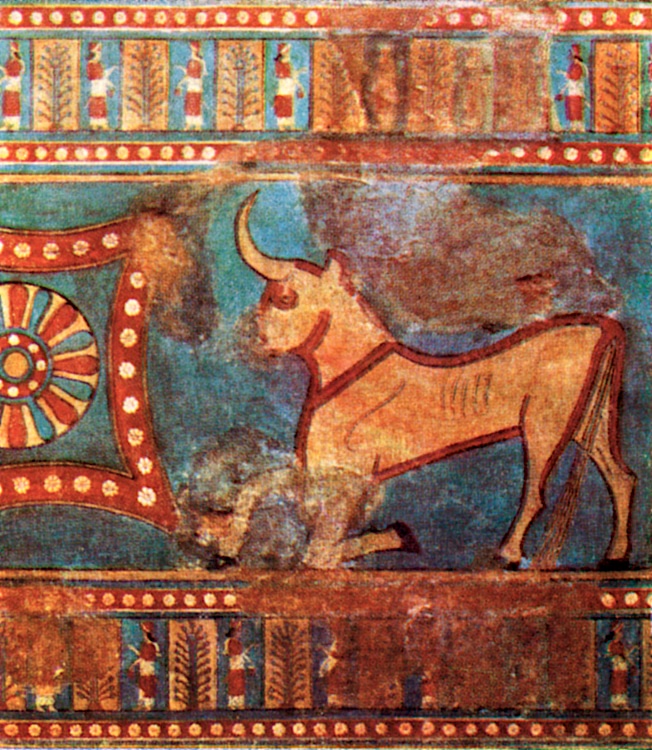
The art produced by the Urartu civilization, which flourished in ancient Armenia, eastern Turkey, and northwestern Iran from the 9th to 6th century BCE, is best seen in bronze figurines of deities, bronze cauldrons with animal and goddess head decorations, and vibrant wall paintings. A mix of Mesopotamian and indigenous subjects coupled with outstanding craft skills make the artworks of Urartu some of the star attractions in the Near Eastern collections of museums worldwide from London to Saint Petersburg.
IDEAS & INFLUENCES
Overshadowed by its more powerful neighbour Assyria (both in the past and today), without surviving examples of extended text of its own, and having had much of its precious material culture destroyed or looted, it can be difficult to disentangle the art of Urartu from that of the civilizations who were its predecessors, contemporaries, and even successors. One is on safer ground when examining the artefacts themselves in isolation rather than searching for their connection to each other and the art of other cultures. Certain points then become clear - the Urartians were master metalworkers, cauldrons especially being a forte. Wall painters were as accomplished as in any other culture, too. Such skills were acquired and developed over many decades, even centuries, and with such skills, one can presume there was also innovation both in technique and ideas. History shows that expert artists do not copy for very long before they begin to experiment.
The Urartu civilization was only rediscovered in the 19th century CE, and it has a lot of catching up to do with its more famous contemporary cultures, but ongoing excavations are steadily building up a clearer picture of the capabilities, inspirations, and legacy of one of the region's most important Bronze and Iron Age cultures. It is clear that Urartian art was particularly influenced by contemporary Assyrian and Near Eastern art and that produced by the earlier cultures of the Hittites and Hurrians. Such subjects as lions, bulls, mythological creatures (eg griffins and centaurs), horse riders, and military themes provide a strong link between all of these cultures. Finally, Egyptian art was not unknown either, and artefacts with hieroglyphs, notably faience bowls and statuettes, have been found at Urartian sites.
EXTENSIVE EXCAVATIONS SUCH AS THOSE AT TEISHEBAINI HAVE REVEALED THE WIDE RANGE OF MATERIALS, MEDIA & SUBJECTS IN URARTIAN ART.
A consequence of these cultural connections, coupled with the lack of identifying inscriptions in many cases, is that some artworks can be difficult to positively identify as made by artists from Urartu, Assyria or the Achaemenid Empire. An added difficulty is that many surviving Urartian artworks come from Assyrian sites where they were either taken as loot or which were produced specifically for that market by Urartian craftsmen. These works, though, may well have been produced during a period of political and artistic decline when Urartian art had lost some of its uniqueness. Thankfully, extensive excavations, such as those at Teishebaini (Karmir-Blur), have revealed the wide range of materials, media and subjects typical of Urartian art.
MATERIALS & MEDIA
Metalworking has a long history in the region, dating back to the 10th millennium BCE. Artisans in the Urartu kingdom had access to local mineral deposits which included gold, silver, copper, lead, iron, and tin. Other metals which the artisans and artists of Urartu could use included alloys such as bronze (copper and tin), brass (copper and zinc), and electrum (gold and silver). Artists also used wood, hardwood, stone, bone, stag horns, semi-precious stones (eg sardonyx, agate, and cornelian), enamel, faience, and ivory for their work. Common media for Urartian art includes figurines, engraved and inlaid weapons and armour, pottery, wall paintings, and highly decorative furniture.

Bas Relief of Teisheba
LARGE-SCALE SCULPTURE
Unfortunately, no large-scale sculpture survives except in fragments. The most important example is the six surviving pieces of a basalt relief statue of the storm god Teisheba. Dating to the 7th century BCE, the original figure stood on a bull facing a second figure with a triple spearhead between the two. It was excavated at Adilcevaz, north of Lake Van, and a full reconstruction has been made which can be seen in the Erebuni Historical and Archaeological Culture Preserve in Yerevan, Armenia.
The largest sculpture suggested by a surviving fragment is a life-size figure of a ruler. Only the torso of the figure has survived but the narrow beard and ends of long hair suggest a royal person. The left hand holds a bow and some arrows while the right hand holds either a club or whip. That such large figure statues were erected at Urartian temples is known through Assyrian inscriptions and artwork which describe and depict attacks on Urartu during the mid- to late-8th century BCE.
METALWORK
Metalworkers cut, cast, embossed, engraved, and inlaid metal to produce such ornate goods as jewellery of all kinds, helmets, shields, quivers, pectorals, small seals and amulets in the shape of bells, horse harness pieces, horse bits, belts, buckles, figurines, and candelabra. Bronze and copper seem to have been the materials of choice. Large bronze cauldrons were a speciality, often with three-dimensional animal or human heads around the rim and as handles. A magnificent bronze bull's head handle ornamentation can today be seen in the British Museum in London.
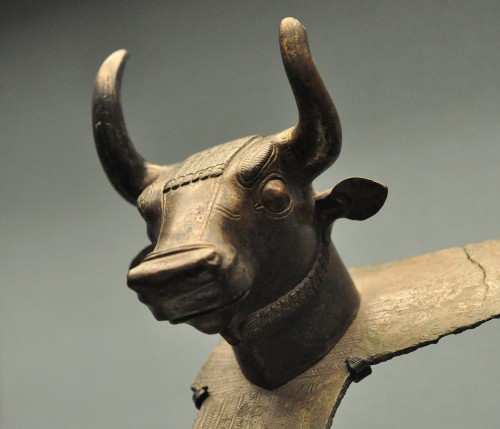
Bronze Bull Head from Urartu
Winged female goddesses are another common choice for cauldron decorations, and they perhaps represent the goddess Tushpuea, the consort of Shivini, the sun god. A splendid example is today in the Hermitage Museum in Saint Petersburg. The cauldrons, having rounded bottoms, were set on embossed bases or tripods. The type, in general, is very similar to Etruscancauldrons, which were likely inspired by the Urartu model, indeed, some examples may well be of Urartian manufacture.
Bronze plaques, placed in niches in interior walls, were etched with geometrical designs and scenes of horsemen and chariots, sometimes even buildings, too. Some plaques have gold and silver leaf decoration. Bronze belts were engraved with hunting scenes, for example, lion-hunts. Shields had large central bosses made in the form of mythical creatures, lions, and bulls.Shields may also show concentric bands of embossed lions and bulls as in the two examples now in the British Museum in London. Those bronze items such as the more ornate shields and weapons belonging to the royal household are so identified by inscriptions which have also helped to identify Urartian works found outside Asia.
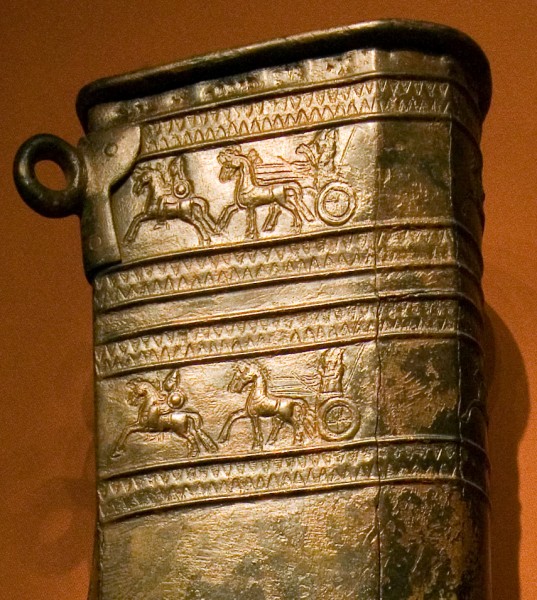
Urartu Decorated Quiver
WALL PAINTING & FLOORING
Excavations have revealed both public and private buildings in Urartian cities had interior wall paintings. The palace complex at the fortress site of Erebuni alone had over 2,000 square metres of wall paintings. Painted on plaster, surviving sections and fragments show scenes with animals, mythical creatures, processions of gods, and scenes from everyday life such as agriculture, cattle breeding, and hunting. The scenes are usually set within broad decorative borders made up of palmettes, geometric shapes or small repeated human figures. Backgrounds are usually white, outlines are drawn in black, and blue and red are the most commonly used colours.
Flooring was of stone in the more prestigious buildings with surviving examples having either large basalt slabs or even large-stone polychrome mosaics with geometric designs. Interior walls could have cavities cut into them into which were placed not only the decorative bronze plaques described above but also decorative cut stone slabs in red, white, or black.
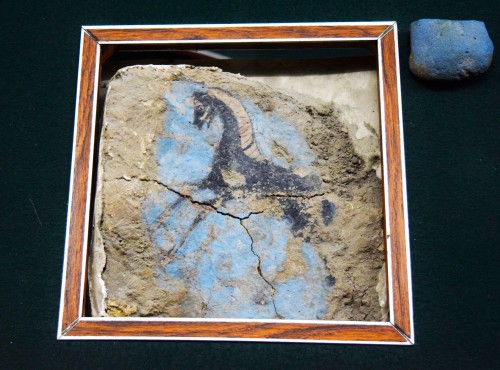
Urartian Horse Mural Fragment
FURNITURE
Furniture was placed in elite tombs, especially thrones and matching stools. Perhaps largely made of wood, they have not survived complete but fragments made from cast or solid metal, usually bronze or copper, do survive. These remnants are highly decorative and take the form of finely sculpted standing human figures or mythical creatures such as winged bulls with human heads or winged bird-lion hybrids which were intended to protect the person who sat on the throne. In some examples of these figures the face may have been rendered in gold or semi-precious stone and, consequently, this part has long-since been removed by looters. The recesses of many of these miniature sculptures contain traces of gold leaf suggesting that the whole was once covered in shining gold.
POTTERY
A wide range of vessels was made both for everyday and ceremonial use. The most common type has a polished red surface while a typical form is the one-handled jug. Large jars were made and then sunk into the floors of storage buildings in which were kept foodstuffs, especially grain, oil, and wine. The largest examples of these had a capacity to hold 750 litres (200 gallons). A label etched in cuneiform very often indicates the contents of storage vessels. One unusual form is the vessel made in the shape of a boot, complete with painted stitching and laces. Several examples have been excavated from the fortress city of Teishebaini and date to the 8th century BCE. Finally, pyxides (small lidded boxes) were produced and decorated with relief or painted scenes of religious and everyday life. There are several surviving examples of these in stone, too.
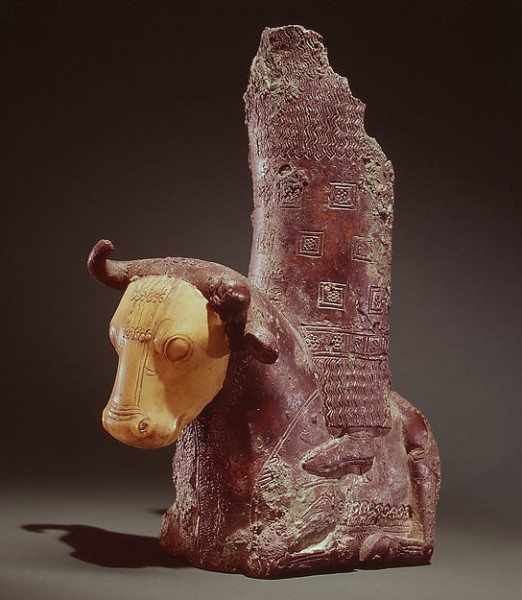
Urartu Deity & Bull
RELIGIOUS ART
Religious art includes bronze figurines of prominent gods such as Haldi, Teisheba, and Shivini. Haldi, the head deity and god of war, is often portrayed as a man with or without a beard standing on a lion, symbolic of his power, courage, and virility. In contrast, Teisheba, the storm god, is shown standing on a bull and holding thunderbolts in his hands. Shivini, the sun god, was often represented as a kneeling man holding a winged solar disk, and was, therefore, likely inspired by the Egyptian god of the same association, Ra.
Some figurines of deities are unidentified, such as a female goddess rendered in bone, and there are, too, strange hybrid figurines of a fish-man, bird-man, and scorpion-man. These latter creatures, frequently painted on storeroom interior walls, were likely regarded as protective spirits. The Tree of Life, another motif from Mesopotamian art, appears in various media, typically with a figure standing either side of it and making offerings.
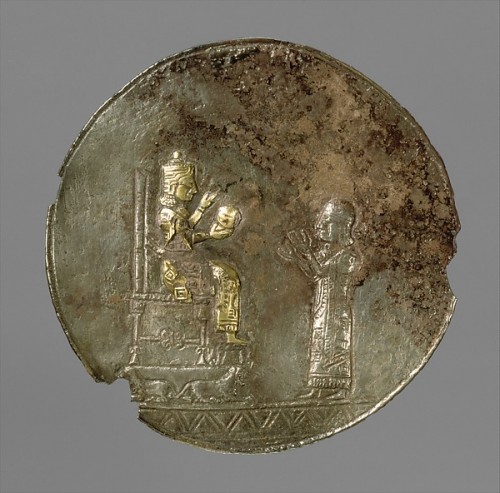
Urartu God & Worshipper
Weapons were made using precious materials which were not for military use but destined as offerings at temples to the gods.Assyrian inscriptions describe temples in Urartu containing silver bows and arrows, gold swords, silver javelins and spears, and even silver chariots. Finally, as perhaps is to be expected for a war god, Haldi is frequently represented on engraved weapons, belts, shields, and medallions.
LEGACY
As already mentioned, there is a striking resemblance in many features of the art and objects produced in Urartu and other cultures in the Near East but also further afield in Archaic Greece, especially on Crete, Rhodes, Samos, Delphi, Corinth, and elsewhere. Etruscan art shows similarities too. Whether these ideas arose independently or were transferred via traders, the exchange of objects or by the movement of artists themselves is a moot question. The point of contact between these various Mediterranean cultures would most likely have been the thriving port of Poseidon (Al Mina) at the mouth of the Orontes River in southeast Turkey, which was controlled by Urartu in the first half of the 8th century BCE.
Some motifs seen in the art of Urartu continued to appear in the art of the region into much later times, just as the Urartian language continued long after the cities had been taken over by the Medes and successive powers. The Tree of Life motif, for example, was still being used in the folk songs and illustrated manuscripts produced in Armenia during the medieval period.
This article was made possible with generous support from the National Association for Armenian Studies and Researchand the Knights of Vartan Fund for Armenian Studies.
Armenian Mythology › Antique Origins
Definition and Origins

The mythology of ancient Armenia is a rich blend of indigenous traditions with imported ideas from neighbouring cultures and migrating peoples added over the centuries. The legends and stories helped to explain natural phenomena, provide an explanation of the nation's origins, and commemorate key historical events such as wars and invasions.
ORIGINS & INSPIRATIONS
The religion of Armenia's first recorded state, Urartu, which was itself a confederation of smaller kingdoms, flourished principally in ancient Armenia from the 9th to 6th century BCE. The Urartu civilization was a unique mix of indigenous, Hurrian, and Mesopotamian gods and symbolism. The pantheon was headed by the trinity of Haldi (god of war ), Teisheba (god of storms), and Shivini (the sun god), who were the principal beneficiaries of sacrifices and temples built in their honour.There were others, as attested by a 9th-century BCE inscription discovered in a niche in the mountains near the capital Tushpa (Van). The list, inscribed in duplicate, mentions 79 gods.
There are elements in Armenian mythology similar to the Vedic tradition of India and Egyptian ideas too, most clearly seen in Shivini, who was often represented as a kneeling man holding a winged solar disk, and therefore likely inspired by the Egyptian god of the same association, Ra. The close cultural relations between Urartu and Assyria are also illustrated by the Urartian application of the Assyrian ideograms for the gods Adad and Shamsh to their own gods Teisheba and Shivini respectively. The Tree of Life (in Armenian tsarrn kenats ), another motif from Mesopotamian art, appears in various media, typically with a figure standing either side of it and making offerings. The Biblical tradition was another source of inspiration for ancient Armenians seeking to explain their surroundings and history.
As in many other ancient cultures, indigenous gods often represented such important elements or prominent natural features as water, earth, the sun, mountains, caves, and trees. Still other deities were related to ancient animalistic beliefs.
OVER TIME THE ORAL & ANCIENT MYTHS WHICH WOVE TOGETHER SUCH DIVERSE CULTURAL THREADS WERE RECORDED IN TEXTS & PERPETUATED ORALLY BY LYRE -PLAYING BARDS.
Over time the oral and ancient myths which wove together such diverse cultural threads were recorded in texts and perpetuated orally by lyre-playing bards ( gusan ) which were, in turn, preserved by even later writers. For example, a portion of an ancient poem recorded by the 5th-century CE historian Movses Khorenatsi describes the birth of the sun god Vahagn (who had replaced Shivini) from a reed in the sea. Unfortunately, though, and despite the best efforts of writers in Late Antiquity, without extended textual evidence from ancient Armenia itself and only an impoverished archaeological record, much of Armenian myth and religion still remains unknown or unexplained. There are small figurines from Urartian sites which are of uncertain significance, for example, of winged females, bird-men, scorpion-men and fish-men. As these hybrid creatures were frequently painted on storeroom interior walls, the most plausible explanation as to their purpose is as protective spirits, but we have no names and no certainty as to their real meaning and purpose. Below, then, are summaries of the most important ancient Armenian myths we know of today.
HAYK & BEL
One of the unique contributions Movses made to Armenian history was his recounting of the foundation myth of the nation (some scholars might say 'inventing'). This is the story of Hayk (Haik) and Bel and places the origins of the Armenian people as the descendants of the biblical Noah via his son Japheth. Hayk, a descendant of Japheth and noted archer (hence his later association with Orion ), rebelled one day against Bel the evil and repressive Babylonian tyrant and returned back to his homeland around Mount Ararat in ancient Armenia, where it was thought Noah's ark had come to rest at the end of the great flood. Bel followed Hayk and his relations so that a mighty battle followed in which Bel was killed. Hayk then gave his name to his descendants, the Hay people, and the name of the region of Armenia in the Armenian language, Hayasa. As with most legends, the grain of truth buried in the fiction is that the story of Hayk and Bel may commemorate the actual conflicts between Armenia (then Urartu) and Assyria, especially in the 8th century BCE. Bel, from the Assyrian baal meaning “lord”, represents the evil and oppressive empire of the Assyrians epitomised by such aggressive war-mongers as Tiglath-Pileser III (r. 745-727 BCE) and Sargon II (722-705 BCE) who both besieged Armenian cities.

View of Mount Ararat from Armenia
The Hayk and Bel myth is much more than just a pleasant story from the country's military past, as here explained by the political historian R. Pannosian:
In terms of popular perception this story is just as important in modern nationalist thinking as 'objective' history.The myth asserts that Armenians are direct descendants of Noah…The roots of the Armenian nation were thus established around Mount Ararat with Haik and his family. This story, taught to all primary students in Armenian schools around the world, has a number of powerful symbolic components. First, it makes Armenia the cradle of all civilizations since Noah's Ark landed on the 'Armenian' mountain of Ararat. Second, it connects Armenians to the biblical narrative of human development. Third, it infuses a very important element of righteous rebellion against tyranny and oppression (of Babylon ). Fourth, it situates freedom, independence and justice at the centre of the nation's origins. And finally, it makes Mount Ararat the national symbol of all Armenians. (51)
SHAMIRAM - SEMIRAMIS
Movses Khorenatsi recounts the legend of Shamiram, probably based on the Assyrian queen Semiramis (r. 811-806 BCE), another historical enemy of the Armenian people. One day Shamiram falls in love with the impossibly handsome Armenian king Ara but, being already married and a picture of moral virtue, he shows no interest in the queen and returns to his country.Shamiram's army then follows Ara and, despite orders that no harm should come to the Armenian king, he is killed by a stray arrow. The distraught queen, having lost the object of her affections, then tries to find consolation in wandering the lands of Ara's kingdom. Eventually, she decides to build a city near Lake Van where she will spend the summer months away from here home capital of Nineveh.
Once the splendid new city is finished, Shamiram takes the body of Ara back to her palace where it is kept at the top of a tower so that supernatural dogs ( aralezk ) might be called to lick him back to life. In one version the dogs perform their miracle and Ara lives once again, but in Movses' version, unfortunately, the dogs never come and so Shamiram, to save face with her people now that the gods have forsaken her, is forced to parade a look-alike to the dead Ara.

Semiramis
The story of Shamiram and Ara is a typical contrast of an evil and immoral foreign ruler against one's own virtuous sovereign and is very similar to the Greek myth of Adonis and the Babylonian Gilgamesh, both of whom reject a goddess' advances with unfortunate consequences. Movses does not, however, paint Shamiram as all bad, for he does credit her with building the ancient Urartian canal of Artamet near Van amongst other architectural and engineering feats, perhaps in acknowledgement that these innovations were assimilated from outside Armenia.
VAHAGN & ASTGHIK
Storms on Lake Van were thought to have been caused by the god Vahagn (the Iranian Verethraghna and broadly equivalent to the Greek Hercules ) and vishaps, serpents who lived in water. Vahagn was also thought responsible for the Milky Way, known to the ancient Armenians as the “Trail of the Straw-Thief” after he stole kindling from Bel, the enemy of the Ara and Armenian people. The birth of Vahagn and his association with the Sun is here described in a poem preserved for posterity by Movses Khorenatsi:
In travail were heaven and earth,In travail, too, the purple sea!The travail held in the sea the small red reed.Through the hollow of the stalk came forth smoke,Through the hollow of the stalk came forth flame,And out of the flame a youth ran!Fiery hair had he,Ay, too, he had flaming beard,And his eyes, they were as suns!(quoted in Kurkjian, 248)
The next parts of the song (now lost) described Vahagn as a fearless dragon-slayer, hence his other name of Vishabakah, literally translated as “dragon reaper”.
Vahagn's consort was Astghik (aka Astlik), the goddess of beauty and love whose name means “little star” (translated from Beldi, the Syrian goddess). Associated with doves and roses, she had a festival dedicated to her at the beginning of summer.One story involving Astghik tells of her habit of bathing in a stream each night. On one occasion a group of local young men, eager to glimpse the naked goddess, lit a fire on a hill to see Astghik better. The goddess foiled the plan by causing a great mist to settle over the area which henceforth acquired the name “Plain of Mush” after the Armenian word mshoush, meaning mist.
LITTLE MITHRA SITS HOLDING AN ORB OF JUSTICE & IS SERVED BY A RAVEN WHILE HE AWAITS THE COMING OF THE APOCALYPSE.
POKR MITHRA - LITTLE MITHRA
Pokr Mithra (from the Iranian god of justice Mithra), also called Mihr, according to the oral tradition which is still recited today, is a god who was thought to dwell in a cave which will only open at the end of Time. Inside the cave, Little Mithra sits holding an orb of justice and is served by a raven while he awaits the coming of the Apocalypse. He was also associated with light and truth. The god has a portal carved into the rock face of the acropolis at Van named after him, the Gate of Mithra (Mheri durrn).Traditionally, offerings were made to the gods at such portals of which Van boasts many. It is possible that Mithraism was passed from Persia to the Roman world via legionaries fighting in ancient Armenia during the Parthian Wars of the 1st century CE.
TORK ANGELEA
Tork Angelea or Tork of Angel is a heroic figure based on Tarkhu, the weather god of Asia Minor. Once again, our source is Movses Khorenatsi, who records an oral legend of a man with great strength who can crush and split rocks before throwing large chunks at his enemies. The legend also tells of Tork scratching designs of eagles onto stone tablets using only his fingernails and throwing stones the size of hills at invading ships on the Black Sea. Perhaps based on an actual conflict in the ancient past, Movses provides the folk etymology of an-gel as “of ferocious men”, and it is interesting to note that the very name of Tarkhu means 'victor' or 'conqueror'. According to Movses, Tork was a descendant of Paskam, the grandson of Hayk.
This article was made possible with generous support from the National Association for Armenian Studies and Researchand the Knights of Vartan Fund for Armenian Studies.
LICENSE:
Article based on information obtained from these sources:with permission from the Website Ancient History Encyclopedia
Content is available under License Creative Commons: Attribution-NonCommercial-ShareAlike 3.0 Unported. CC-BY-NC-SA License